HI6008 - House Prices & Socioeconomic Factors: A Literature Review
VerifiedAdded on 2023/06/13
|12
|4063
|145
Literature Review
AI Summary
This literature review examines the socioeconomic impacts of rising house prices on low-income earners in Sydney, Australia. It explores the causes of rising house prices, including income increases, investment rates, demographic changes, and speculative demand. The review then details the effects on low-income earners, such as a lower standard of living, increased unemployment, decreased social and cultural diversity, and reduced self-esteem. The paper draws upon various sources to provide a comprehensive overview of the complex relationship between house prices and socioeconomic well-being, particularly for vulnerable populations in Sydney. Desklib provides access to similar solved assignments for students.
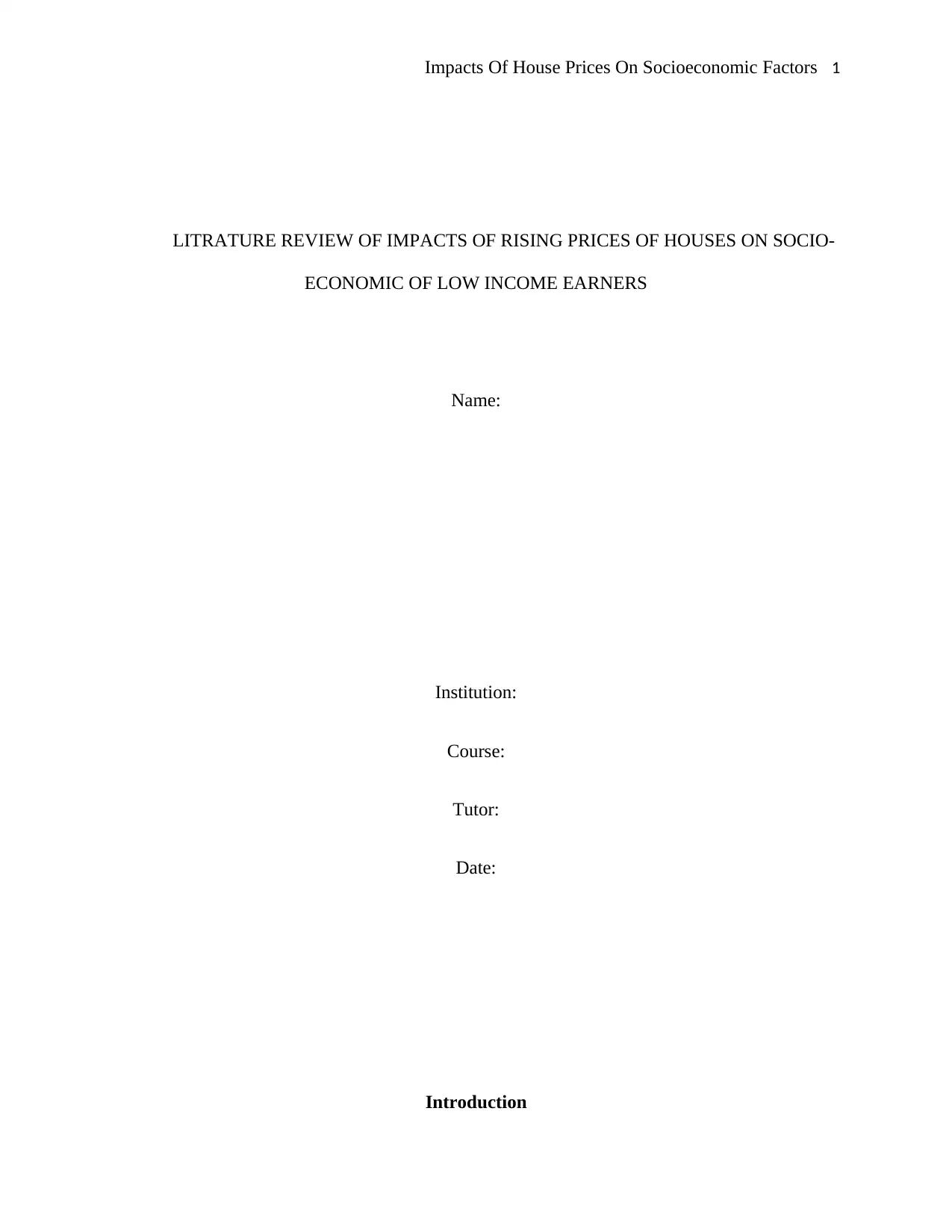
Impacts Of House Prices On Socioeconomic Factors 1
LITRATURE REVIEW OF IMPACTS OF RISING PRICES OF HOUSES ON SOCIO-
ECONOMIC OF LOW INCOME EARNERS
Name:
Institution:
Course:
Tutor:
Date:
Introduction
LITRATURE REVIEW OF IMPACTS OF RISING PRICES OF HOUSES ON SOCIO-
ECONOMIC OF LOW INCOME EARNERS
Name:
Institution:
Course:
Tutor:
Date:
Introduction
Paraphrase This Document
Need a fresh take? Get an instant paraphrase of this document with our AI Paraphraser
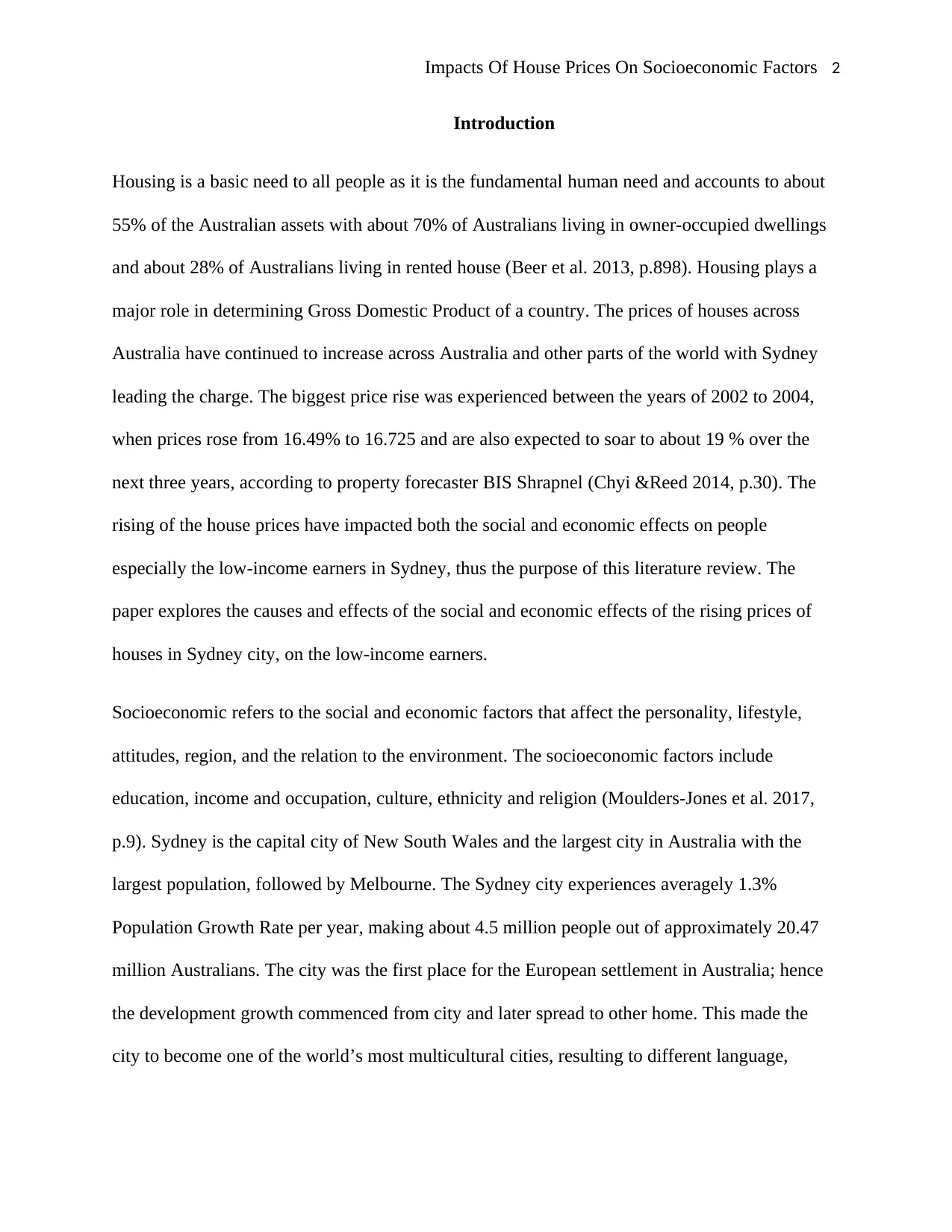
Impacts Of House Prices On Socioeconomic Factors 2
Introduction
Housing is a basic need to all people as it is the fundamental human need and accounts to about
55% of the Australian assets with about 70% of Australians living in owner-occupied dwellings
and about 28% of Australians living in rented house (Beer et al. 2013, p.898). Housing plays a
major role in determining Gross Domestic Product of a country. The prices of houses across
Australia have continued to increase across Australia and other parts of the world with Sydney
leading the charge. The biggest price rise was experienced between the years of 2002 to 2004,
when prices rose from 16.49% to 16.725 and are also expected to soar to about 19 % over the
next three years, according to property forecaster BIS Shrapnel (Chyi &Reed 2014, p.30). The
rising of the house prices have impacted both the social and economic effects on people
especially the low-income earners in Sydney, thus the purpose of this literature review. The
paper explores the causes and effects of the social and economic effects of the rising prices of
houses in Sydney city, on the low-income earners.
Socioeconomic refers to the social and economic factors that affect the personality, lifestyle,
attitudes, region, and the relation to the environment. The socioeconomic factors include
education, income and occupation, culture, ethnicity and religion (Moulders-Jones et al. 2017,
p.9). Sydney is the capital city of New South Wales and the largest city in Australia with the
largest population, followed by Melbourne. The Sydney city experiences averagely 1.3%
Population Growth Rate per year, making about 4.5 million people out of approximately 20.47
million Australians. The city was the first place for the European settlement in Australia; hence
the development growth commenced from city and later spread to other home. This made the
city to become one of the world’s most multicultural cities, resulting to different language,
Introduction
Housing is a basic need to all people as it is the fundamental human need and accounts to about
55% of the Australian assets with about 70% of Australians living in owner-occupied dwellings
and about 28% of Australians living in rented house (Beer et al. 2013, p.898). Housing plays a
major role in determining Gross Domestic Product of a country. The prices of houses across
Australia have continued to increase across Australia and other parts of the world with Sydney
leading the charge. The biggest price rise was experienced between the years of 2002 to 2004,
when prices rose from 16.49% to 16.725 and are also expected to soar to about 19 % over the
next three years, according to property forecaster BIS Shrapnel (Chyi &Reed 2014, p.30). The
rising of the house prices have impacted both the social and economic effects on people
especially the low-income earners in Sydney, thus the purpose of this literature review. The
paper explores the causes and effects of the social and economic effects of the rising prices of
houses in Sydney city, on the low-income earners.
Socioeconomic refers to the social and economic factors that affect the personality, lifestyle,
attitudes, region, and the relation to the environment. The socioeconomic factors include
education, income and occupation, culture, ethnicity and religion (Moulders-Jones et al. 2017,
p.9). Sydney is the capital city of New South Wales and the largest city in Australia with the
largest population, followed by Melbourne. The Sydney city experiences averagely 1.3%
Population Growth Rate per year, making about 4.5 million people out of approximately 20.47
million Australians. The city was the first place for the European settlement in Australia; hence
the development growth commenced from city and later spread to other home. This made the
city to become one of the world’s most multicultural cities, resulting to different language,
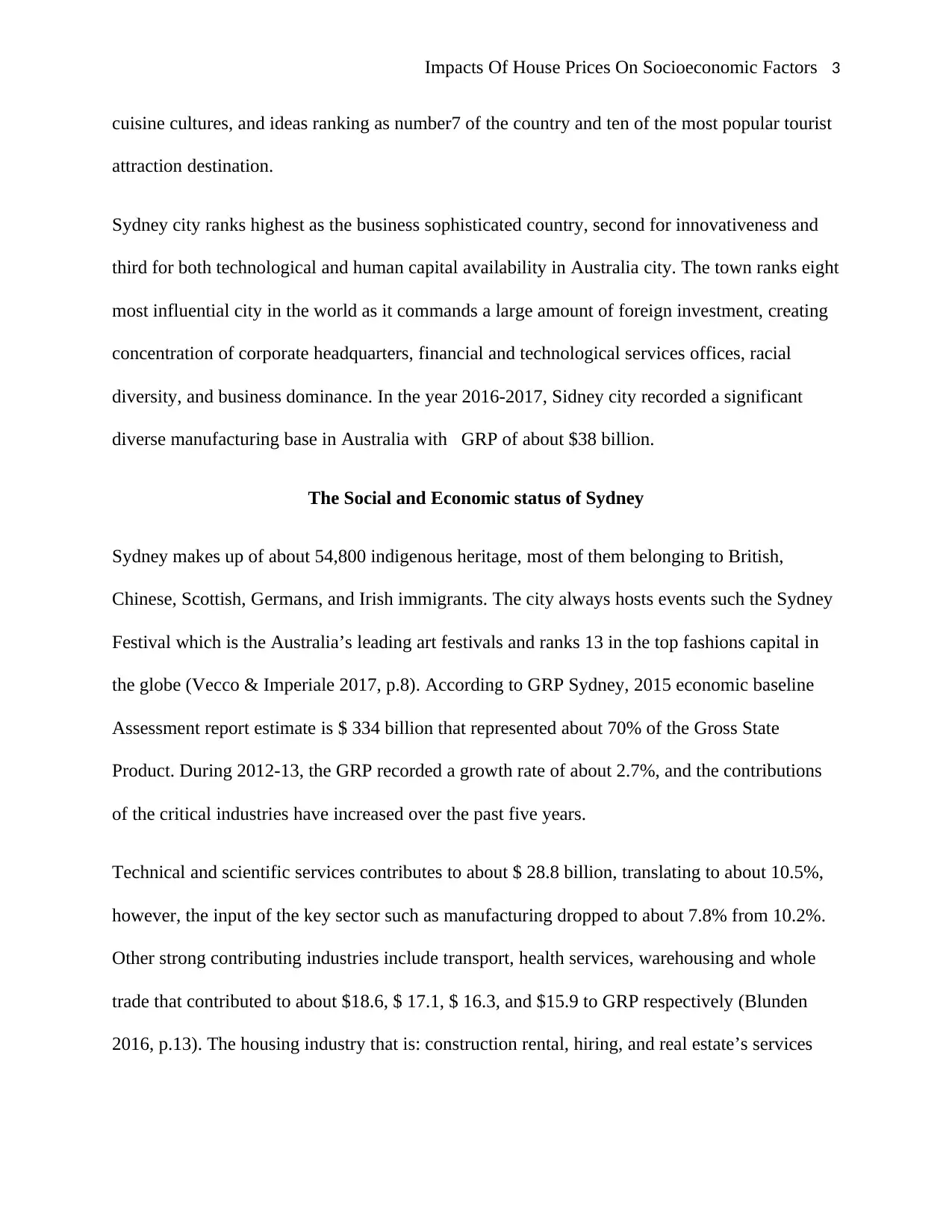
Impacts Of House Prices On Socioeconomic Factors 3
cuisine cultures, and ideas ranking as number7 of the country and ten of the most popular tourist
attraction destination.
Sydney city ranks highest as the business sophisticated country, second for innovativeness and
third for both technological and human capital availability in Australia city. The town ranks eight
most influential city in the world as it commands a large amount of foreign investment, creating
concentration of corporate headquarters, financial and technological services offices, racial
diversity, and business dominance. In the year 2016-2017, Sidney city recorded a significant
diverse manufacturing base in Australia with GRP of about $38 billion.
The Social and Economic status of Sydney
Sydney makes up of about 54,800 indigenous heritage, most of them belonging to British,
Chinese, Scottish, Germans, and Irish immigrants. The city always hosts events such the Sydney
Festival which is the Australia’s leading art festivals and ranks 13 in the top fashions capital in
the globe (Vecco & Imperiale 2017, p.8). According to GRP Sydney, 2015 economic baseline
Assessment report estimate is $ 334 billion that represented about 70% of the Gross State
Product. During 2012-13, the GRP recorded a growth rate of about 2.7%, and the contributions
of the critical industries have increased over the past five years.
Technical and scientific services contributes to about $ 28.8 billion, translating to about 10.5%,
however, the input of the key sector such as manufacturing dropped to about 7.8% from 10.2%.
Other strong contributing industries include transport, health services, warehousing and whole
trade that contributed to about $18.6, $ 17.1, $ 16.3, and $15.9 to GRP respectively (Blunden
2016, p.13). The housing industry that is: construction rental, hiring, and real estate’s services
cuisine cultures, and ideas ranking as number7 of the country and ten of the most popular tourist
attraction destination.
Sydney city ranks highest as the business sophisticated country, second for innovativeness and
third for both technological and human capital availability in Australia city. The town ranks eight
most influential city in the world as it commands a large amount of foreign investment, creating
concentration of corporate headquarters, financial and technological services offices, racial
diversity, and business dominance. In the year 2016-2017, Sidney city recorded a significant
diverse manufacturing base in Australia with GRP of about $38 billion.
The Social and Economic status of Sydney
Sydney makes up of about 54,800 indigenous heritage, most of them belonging to British,
Chinese, Scottish, Germans, and Irish immigrants. The city always hosts events such the Sydney
Festival which is the Australia’s leading art festivals and ranks 13 in the top fashions capital in
the globe (Vecco & Imperiale 2017, p.8). According to GRP Sydney, 2015 economic baseline
Assessment report estimate is $ 334 billion that represented about 70% of the Gross State
Product. During 2012-13, the GRP recorded a growth rate of about 2.7%, and the contributions
of the critical industries have increased over the past five years.
Technical and scientific services contributes to about $ 28.8 billion, translating to about 10.5%,
however, the input of the key sector such as manufacturing dropped to about 7.8% from 10.2%.
Other strong contributing industries include transport, health services, warehousing and whole
trade that contributed to about $18.6, $ 17.1, $ 16.3, and $15.9 to GRP respectively (Blunden
2016, p.13). The housing industry that is: construction rental, hiring, and real estate’s services
⊘ This is a preview!⊘
Do you want full access?
Subscribe today to unlock all pages.

Trusted by 1+ million students worldwide
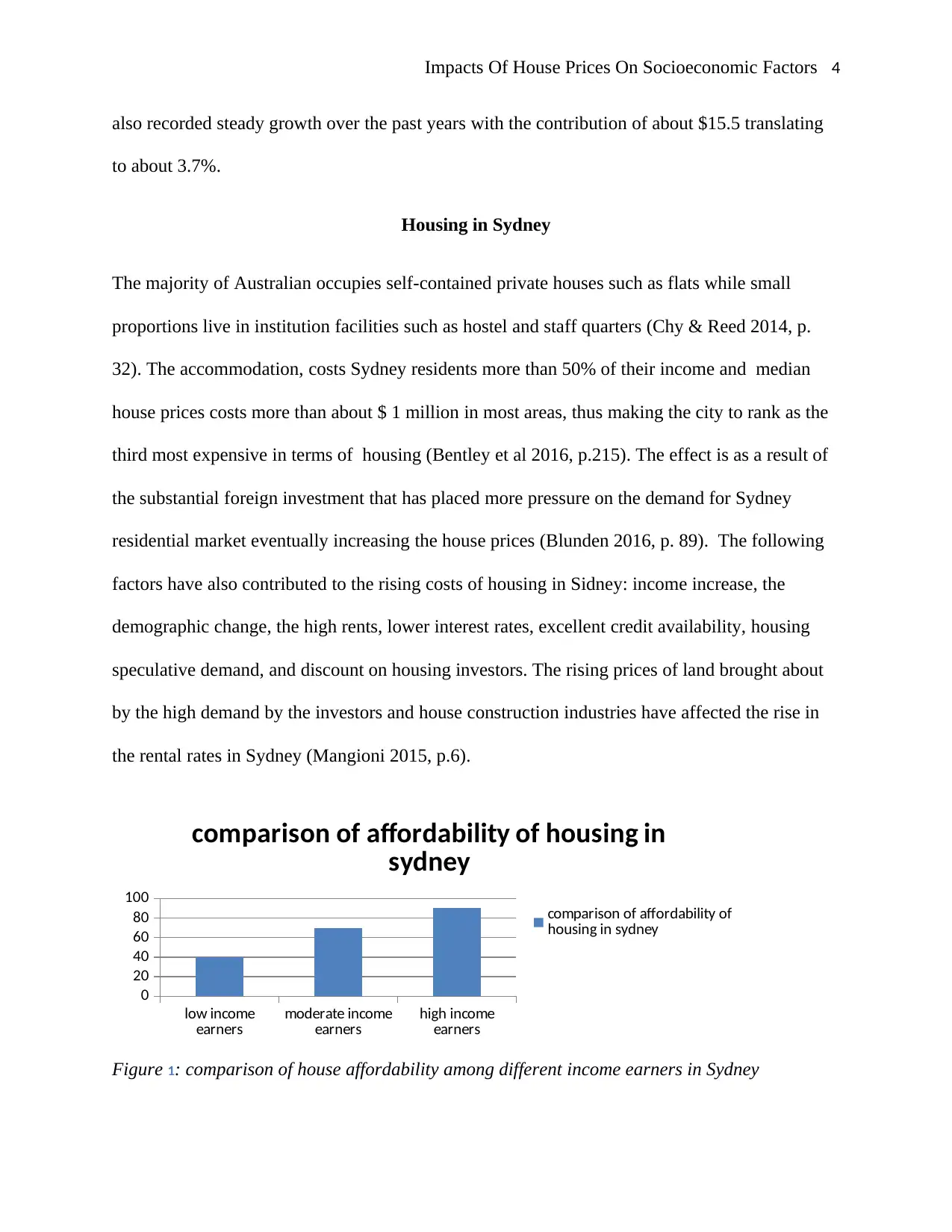
Impacts Of House Prices On Socioeconomic Factors 4
also recorded steady growth over the past years with the contribution of about $15.5 translating
to about 3.7%.
Housing in Sydney
The majority of Australian occupies self-contained private houses such as flats while small
proportions live in institution facilities such as hostel and staff quarters (Chy & Reed 2014, p.
32). The accommodation, costs Sydney residents more than 50% of their income and median
house prices costs more than about $ 1 million in most areas, thus making the city to rank as the
third most expensive in terms of housing (Bentley et al 2016, p.215). The effect is as a result of
the substantial foreign investment that has placed more pressure on the demand for Sydney
residential market eventually increasing the house prices (Blunden 2016, p. 89). The following
factors have also contributed to the rising costs of housing in Sidney: income increase, the
demographic change, the high rents, lower interest rates, excellent credit availability, housing
speculative demand, and discount on housing investors. The rising prices of land brought about
by the high demand by the investors and house construction industries have affected the rise in
the rental rates in Sydney (Mangioni 2015, p.6).
low income
earners moderate income
earners high income
earners
0
20
40
60
80
100
comparison of affordability of housing in
sydney
comparison of affordability of
housing in sydney
Figure 1: comparison of house affordability among different income earners in Sydney
also recorded steady growth over the past years with the contribution of about $15.5 translating
to about 3.7%.
Housing in Sydney
The majority of Australian occupies self-contained private houses such as flats while small
proportions live in institution facilities such as hostel and staff quarters (Chy & Reed 2014, p.
32). The accommodation, costs Sydney residents more than 50% of their income and median
house prices costs more than about $ 1 million in most areas, thus making the city to rank as the
third most expensive in terms of housing (Bentley et al 2016, p.215). The effect is as a result of
the substantial foreign investment that has placed more pressure on the demand for Sydney
residential market eventually increasing the house prices (Blunden 2016, p. 89). The following
factors have also contributed to the rising costs of housing in Sidney: income increase, the
demographic change, the high rents, lower interest rates, excellent credit availability, housing
speculative demand, and discount on housing investors. The rising prices of land brought about
by the high demand by the investors and house construction industries have affected the rise in
the rental rates in Sydney (Mangioni 2015, p.6).
low income
earners moderate income
earners high income
earners
0
20
40
60
80
100
comparison of affordability of housing in
sydney
comparison of affordability of
housing in sydney
Figure 1: comparison of house affordability among different income earners in Sydney
Paraphrase This Document
Need a fresh take? Get an instant paraphrase of this document with our AI Paraphraser
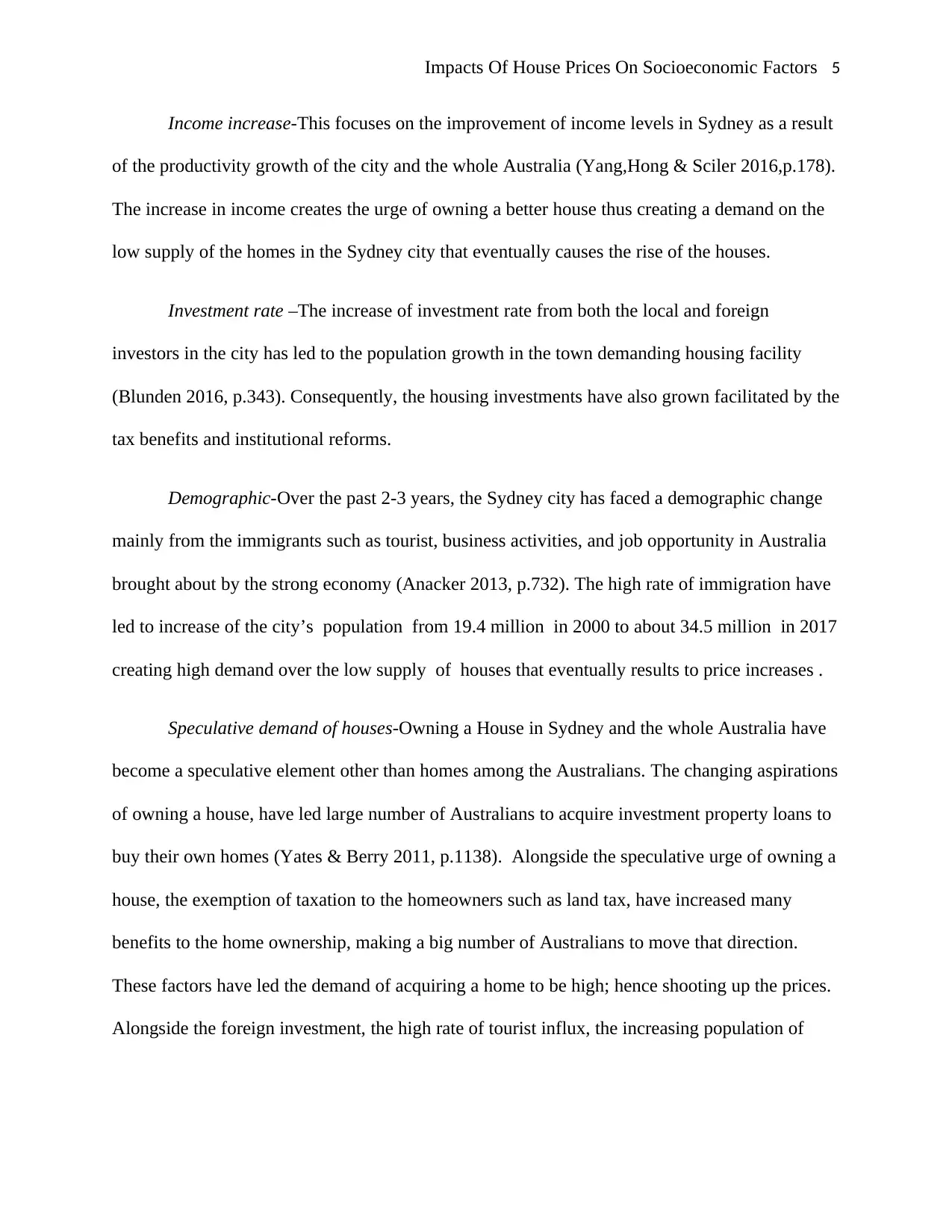
Impacts Of House Prices On Socioeconomic Factors 5
Income increase-This focuses on the improvement of income levels in Sydney as a result
of the productivity growth of the city and the whole Australia (Yang,Hong & Sciler 2016,p.178).
The increase in income creates the urge of owning a better house thus creating a demand on the
low supply of the homes in the Sydney city that eventually causes the rise of the houses.
Investment rate –The increase of investment rate from both the local and foreign
investors in the city has led to the population growth in the town demanding housing facility
(Blunden 2016, p.343). Consequently, the housing investments have also grown facilitated by the
tax benefits and institutional reforms.
Demographic-Over the past 2-3 years, the Sydney city has faced a demographic change
mainly from the immigrants such as tourist, business activities, and job opportunity in Australia
brought about by the strong economy (Anacker 2013, p.732). The high rate of immigration have
led to increase of the city’s population from 19.4 million in 2000 to about 34.5 million in 2017
creating high demand over the low supply of houses that eventually results to price increases .
Speculative demand of houses-Owning a House in Sydney and the whole Australia have
become a speculative element other than homes among the Australians. The changing aspirations
of owning a house, have led large number of Australians to acquire investment property loans to
buy their own homes (Yates & Berry 2011, p.1138). Alongside the speculative urge of owning a
house, the exemption of taxation to the homeowners such as land tax, have increased many
benefits to the home ownership, making a big number of Australians to move that direction.
These factors have led the demand of acquiring a home to be high; hence shooting up the prices.
Alongside the foreign investment, the high rate of tourist influx, the increasing population of
Income increase-This focuses on the improvement of income levels in Sydney as a result
of the productivity growth of the city and the whole Australia (Yang,Hong & Sciler 2016,p.178).
The increase in income creates the urge of owning a better house thus creating a demand on the
low supply of the homes in the Sydney city that eventually causes the rise of the houses.
Investment rate –The increase of investment rate from both the local and foreign
investors in the city has led to the population growth in the town demanding housing facility
(Blunden 2016, p.343). Consequently, the housing investments have also grown facilitated by the
tax benefits and institutional reforms.
Demographic-Over the past 2-3 years, the Sydney city has faced a demographic change
mainly from the immigrants such as tourist, business activities, and job opportunity in Australia
brought about by the strong economy (Anacker 2013, p.732). The high rate of immigration have
led to increase of the city’s population from 19.4 million in 2000 to about 34.5 million in 2017
creating high demand over the low supply of houses that eventually results to price increases .
Speculative demand of houses-Owning a House in Sydney and the whole Australia have
become a speculative element other than homes among the Australians. The changing aspirations
of owning a house, have led large number of Australians to acquire investment property loans to
buy their own homes (Yates & Berry 2011, p.1138). Alongside the speculative urge of owning a
house, the exemption of taxation to the homeowners such as land tax, have increased many
benefits to the home ownership, making a big number of Australians to move that direction.
These factors have led the demand of acquiring a home to be high; hence shooting up the prices.
Alongside the foreign investment, the high rate of tourist influx, the increasing population of
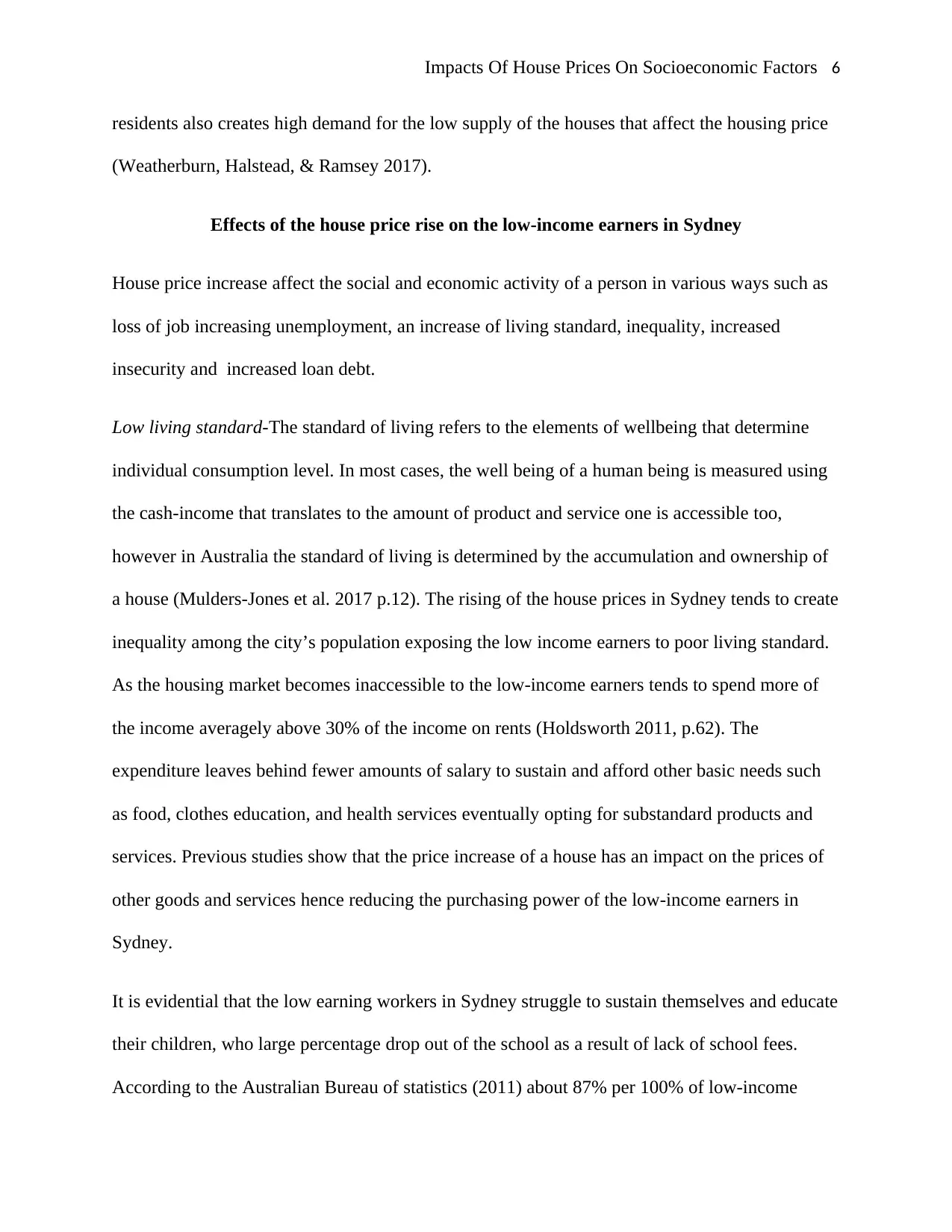
Impacts Of House Prices On Socioeconomic Factors 6
residents also creates high demand for the low supply of the houses that affect the housing price
(Weatherburn, Halstead, & Ramsey 2017).
Effects of the house price rise on the low-income earners in Sydney
House price increase affect the social and economic activity of a person in various ways such as
loss of job increasing unemployment, an increase of living standard, inequality, increased
insecurity and increased loan debt.
Low living standard-The standard of living refers to the elements of wellbeing that determine
individual consumption level. In most cases, the well being of a human being is measured using
the cash-income that translates to the amount of product and service one is accessible too,
however in Australia the standard of living is determined by the accumulation and ownership of
a house (Mulders-Jones et al. 2017 p.12). The rising of the house prices in Sydney tends to create
inequality among the city’s population exposing the low income earners to poor living standard.
As the housing market becomes inaccessible to the low-income earners tends to spend more of
the income averagely above 30% of the income on rents (Holdsworth 2011, p.62). The
expenditure leaves behind fewer amounts of salary to sustain and afford other basic needs such
as food, clothes education, and health services eventually opting for substandard products and
services. Previous studies show that the price increase of a house has an impact on the prices of
other goods and services hence reducing the purchasing power of the low-income earners in
Sydney.
It is evidential that the low earning workers in Sydney struggle to sustain themselves and educate
their children, who large percentage drop out of the school as a result of lack of school fees.
According to the Australian Bureau of statistics (2011) about 87% per 100% of low-income
residents also creates high demand for the low supply of the houses that affect the housing price
(Weatherburn, Halstead, & Ramsey 2017).
Effects of the house price rise on the low-income earners in Sydney
House price increase affect the social and economic activity of a person in various ways such as
loss of job increasing unemployment, an increase of living standard, inequality, increased
insecurity and increased loan debt.
Low living standard-The standard of living refers to the elements of wellbeing that determine
individual consumption level. In most cases, the well being of a human being is measured using
the cash-income that translates to the amount of product and service one is accessible too,
however in Australia the standard of living is determined by the accumulation and ownership of
a house (Mulders-Jones et al. 2017 p.12). The rising of the house prices in Sydney tends to create
inequality among the city’s population exposing the low income earners to poor living standard.
As the housing market becomes inaccessible to the low-income earners tends to spend more of
the income averagely above 30% of the income on rents (Holdsworth 2011, p.62). The
expenditure leaves behind fewer amounts of salary to sustain and afford other basic needs such
as food, clothes education, and health services eventually opting for substandard products and
services. Previous studies show that the price increase of a house has an impact on the prices of
other goods and services hence reducing the purchasing power of the low-income earners in
Sydney.
It is evidential that the low earning workers in Sydney struggle to sustain themselves and educate
their children, who large percentage drop out of the school as a result of lack of school fees.
According to the Australian Bureau of statistics (2011) about 87% per 100% of low-income
⊘ This is a preview!⊘
Do you want full access?
Subscribe today to unlock all pages.

Trusted by 1+ million students worldwide
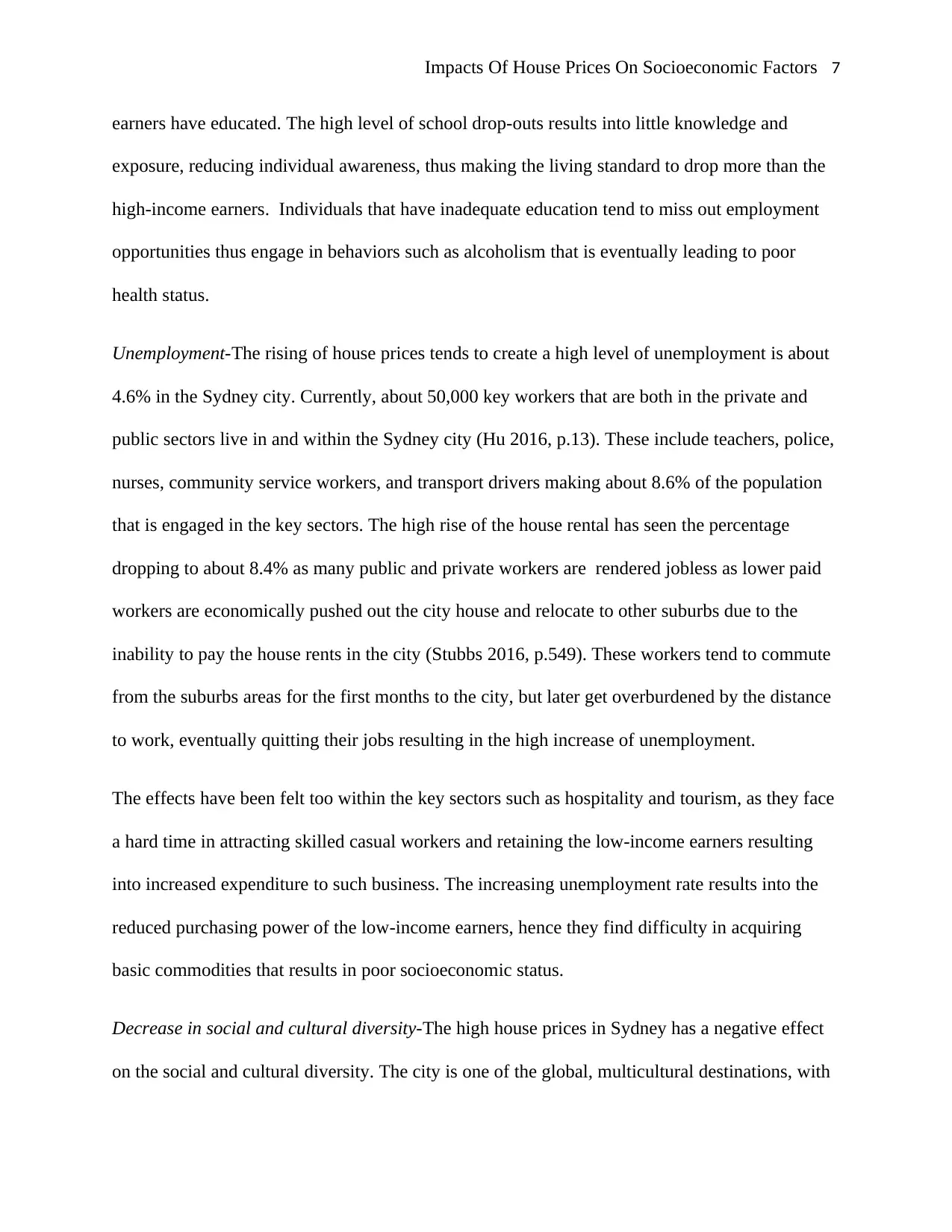
Impacts Of House Prices On Socioeconomic Factors 7
earners have educated. The high level of school drop-outs results into little knowledge and
exposure, reducing individual awareness, thus making the living standard to drop more than the
high-income earners. Individuals that have inadequate education tend to miss out employment
opportunities thus engage in behaviors such as alcoholism that is eventually leading to poor
health status.
Unemployment-The rising of house prices tends to create a high level of unemployment is about
4.6% in the Sydney city. Currently, about 50,000 key workers that are both in the private and
public sectors live in and within the Sydney city (Hu 2016, p.13). These include teachers, police,
nurses, community service workers, and transport drivers making about 8.6% of the population
that is engaged in the key sectors. The high rise of the house rental has seen the percentage
dropping to about 8.4% as many public and private workers are rendered jobless as lower paid
workers are economically pushed out the city house and relocate to other suburbs due to the
inability to pay the house rents in the city (Stubbs 2016, p.549). These workers tend to commute
from the suburbs areas for the first months to the city, but later get overburdened by the distance
to work, eventually quitting their jobs resulting in the high increase of unemployment.
The effects have been felt too within the key sectors such as hospitality and tourism, as they face
a hard time in attracting skilled casual workers and retaining the low-income earners resulting
into increased expenditure to such business. The increasing unemployment rate results into the
reduced purchasing power of the low-income earners, hence they find difficulty in acquiring
basic commodities that results in poor socioeconomic status.
Decrease in social and cultural diversity-The high house prices in Sydney has a negative effect
on the social and cultural diversity. The city is one of the global, multicultural destinations, with
earners have educated. The high level of school drop-outs results into little knowledge and
exposure, reducing individual awareness, thus making the living standard to drop more than the
high-income earners. Individuals that have inadequate education tend to miss out employment
opportunities thus engage in behaviors such as alcoholism that is eventually leading to poor
health status.
Unemployment-The rising of house prices tends to create a high level of unemployment is about
4.6% in the Sydney city. Currently, about 50,000 key workers that are both in the private and
public sectors live in and within the Sydney city (Hu 2016, p.13). These include teachers, police,
nurses, community service workers, and transport drivers making about 8.6% of the population
that is engaged in the key sectors. The high rise of the house rental has seen the percentage
dropping to about 8.4% as many public and private workers are rendered jobless as lower paid
workers are economically pushed out the city house and relocate to other suburbs due to the
inability to pay the house rents in the city (Stubbs 2016, p.549). These workers tend to commute
from the suburbs areas for the first months to the city, but later get overburdened by the distance
to work, eventually quitting their jobs resulting in the high increase of unemployment.
The effects have been felt too within the key sectors such as hospitality and tourism, as they face
a hard time in attracting skilled casual workers and retaining the low-income earners resulting
into increased expenditure to such business. The increasing unemployment rate results into the
reduced purchasing power of the low-income earners, hence they find difficulty in acquiring
basic commodities that results in poor socioeconomic status.
Decrease in social and cultural diversity-The high house prices in Sydney has a negative effect
on the social and cultural diversity. The city is one of the global, multicultural destinations, with
Paraphrase This Document
Need a fresh take? Get an instant paraphrase of this document with our AI Paraphraser
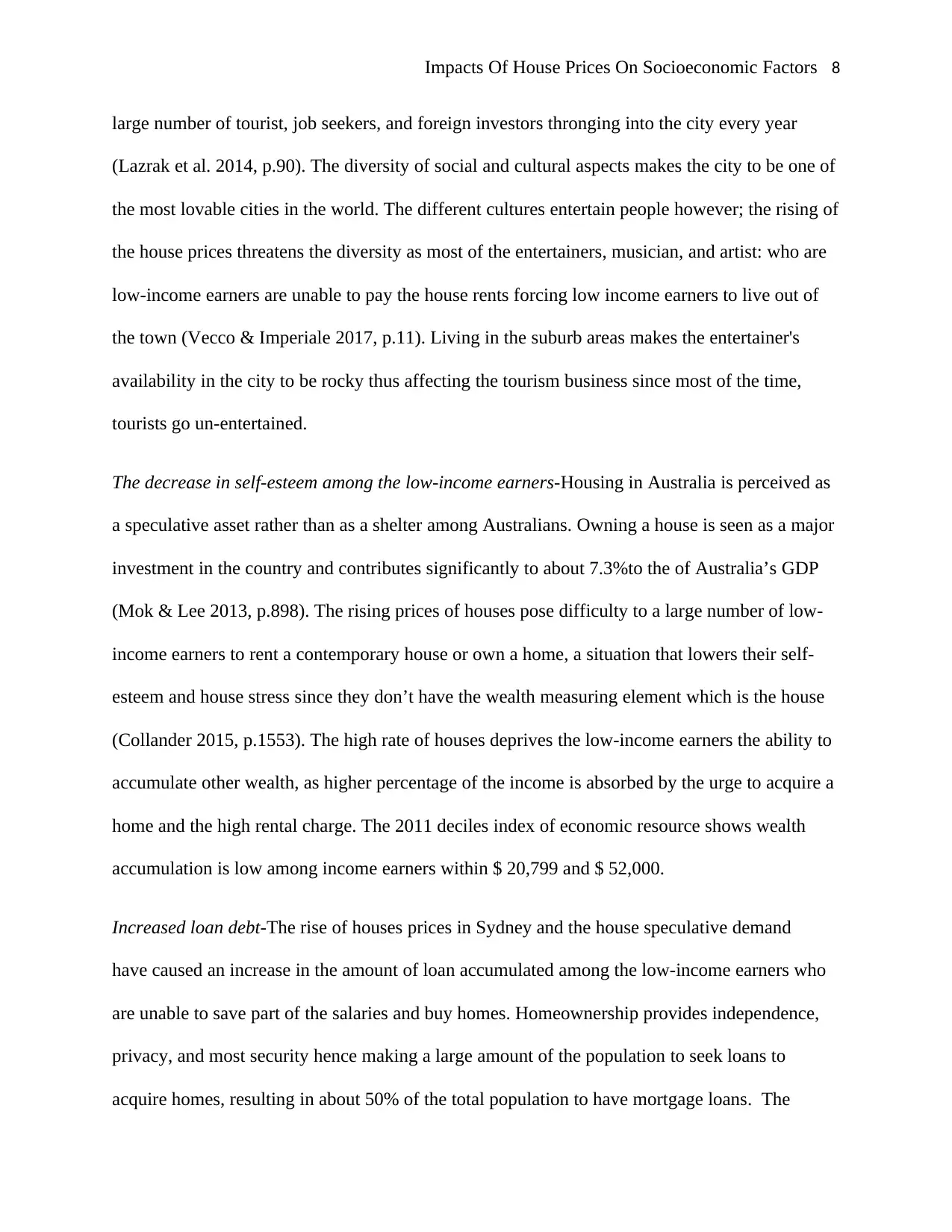
Impacts Of House Prices On Socioeconomic Factors 8
large number of tourist, job seekers, and foreign investors thronging into the city every year
(Lazrak et al. 2014, p.90). The diversity of social and cultural aspects makes the city to be one of
the most lovable cities in the world. The different cultures entertain people however; the rising of
the house prices threatens the diversity as most of the entertainers, musician, and artist: who are
low-income earners are unable to pay the house rents forcing low income earners to live out of
the town (Vecco & Imperiale 2017, p.11). Living in the suburb areas makes the entertainer's
availability in the city to be rocky thus affecting the tourism business since most of the time,
tourists go un-entertained.
The decrease in self-esteem among the low-income earners-Housing in Australia is perceived as
a speculative asset rather than as a shelter among Australians. Owning a house is seen as a major
investment in the country and contributes significantly to about 7.3%to the of Australia’s GDP
(Mok & Lee 2013, p.898). The rising prices of houses pose difficulty to a large number of low-
income earners to rent a contemporary house or own a home, a situation that lowers their self-
esteem and house stress since they don’t have the wealth measuring element which is the house
(Collander 2015, p.1553). The high rate of houses deprives the low-income earners the ability to
accumulate other wealth, as higher percentage of the income is absorbed by the urge to acquire a
home and the high rental charge. The 2011 deciles index of economic resource shows wealth
accumulation is low among income earners within $ 20,799 and $ 52,000.
Increased loan debt-The rise of houses prices in Sydney and the house speculative demand
have caused an increase in the amount of loan accumulated among the low-income earners who
are unable to save part of the salaries and buy homes. Homeownership provides independence,
privacy, and most security hence making a large amount of the population to seek loans to
acquire homes, resulting in about 50% of the total population to have mortgage loans. The
large number of tourist, job seekers, and foreign investors thronging into the city every year
(Lazrak et al. 2014, p.90). The diversity of social and cultural aspects makes the city to be one of
the most lovable cities in the world. The different cultures entertain people however; the rising of
the house prices threatens the diversity as most of the entertainers, musician, and artist: who are
low-income earners are unable to pay the house rents forcing low income earners to live out of
the town (Vecco & Imperiale 2017, p.11). Living in the suburb areas makes the entertainer's
availability in the city to be rocky thus affecting the tourism business since most of the time,
tourists go un-entertained.
The decrease in self-esteem among the low-income earners-Housing in Australia is perceived as
a speculative asset rather than as a shelter among Australians. Owning a house is seen as a major
investment in the country and contributes significantly to about 7.3%to the of Australia’s GDP
(Mok & Lee 2013, p.898). The rising prices of houses pose difficulty to a large number of low-
income earners to rent a contemporary house or own a home, a situation that lowers their self-
esteem and house stress since they don’t have the wealth measuring element which is the house
(Collander 2015, p.1553). The high rate of houses deprives the low-income earners the ability to
accumulate other wealth, as higher percentage of the income is absorbed by the urge to acquire a
home and the high rental charge. The 2011 deciles index of economic resource shows wealth
accumulation is low among income earners within $ 20,799 and $ 52,000.
Increased loan debt-The rise of houses prices in Sydney and the house speculative demand
have caused an increase in the amount of loan accumulated among the low-income earners who
are unable to save part of the salaries and buy homes. Homeownership provides independence,
privacy, and most security hence making a large amount of the population to seek loans to
acquire homes, resulting in about 50% of the total population to have mortgage loans. The
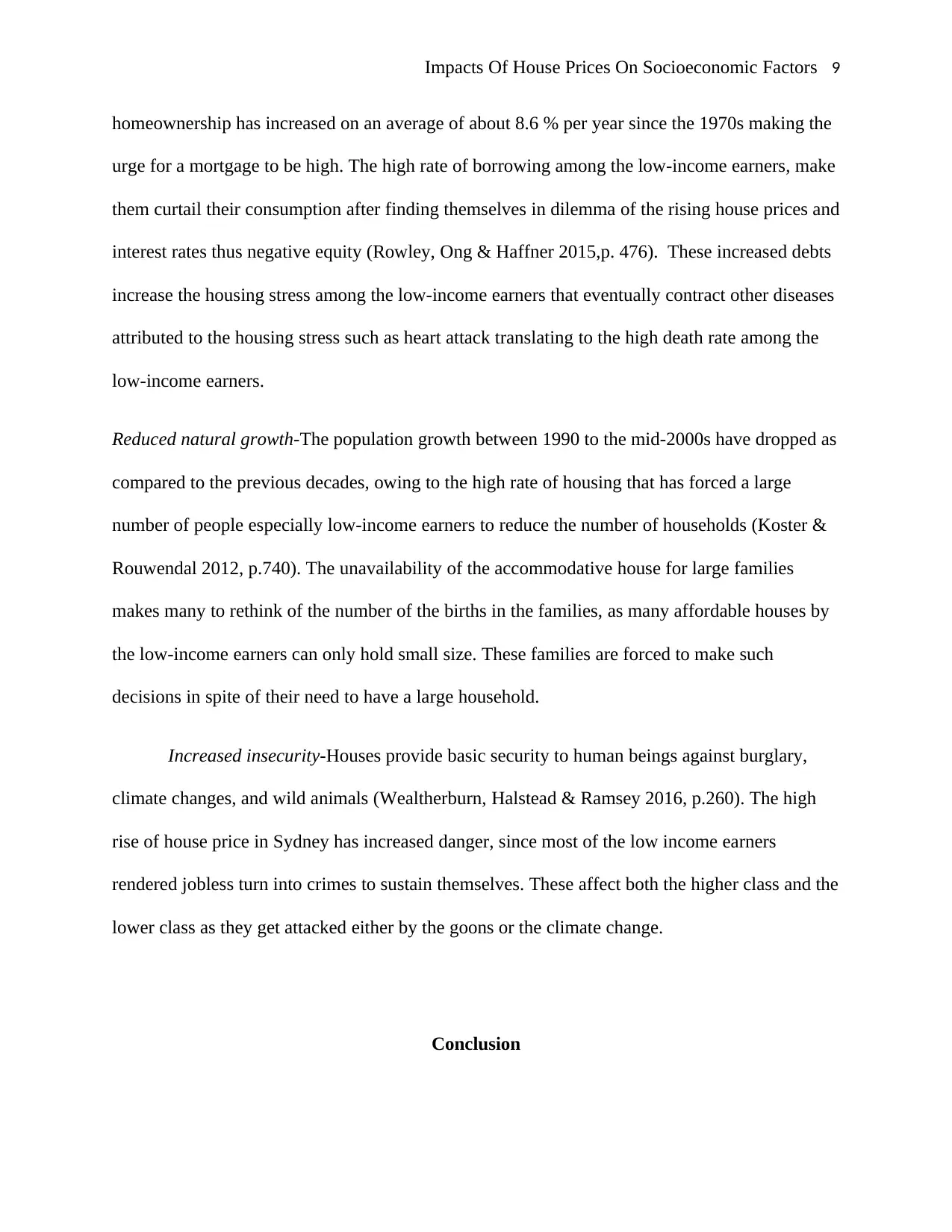
Impacts Of House Prices On Socioeconomic Factors 9
homeownership has increased on an average of about 8.6 % per year since the 1970s making the
urge for a mortgage to be high. The high rate of borrowing among the low-income earners, make
them curtail their consumption after finding themselves in dilemma of the rising house prices and
interest rates thus negative equity (Rowley, Ong & Haffner 2015,p. 476). These increased debts
increase the housing stress among the low-income earners that eventually contract other diseases
attributed to the housing stress such as heart attack translating to the high death rate among the
low-income earners.
Reduced natural growth-The population growth between 1990 to the mid-2000s have dropped as
compared to the previous decades, owing to the high rate of housing that has forced a large
number of people especially low-income earners to reduce the number of households (Koster &
Rouwendal 2012, p.740). The unavailability of the accommodative house for large families
makes many to rethink of the number of the births in the families, as many affordable houses by
the low-income earners can only hold small size. These families are forced to make such
decisions in spite of their need to have a large household.
Increased insecurity-Houses provide basic security to human beings against burglary,
climate changes, and wild animals (Wealtherburn, Halstead & Ramsey 2016, p.260). The high
rise of house price in Sydney has increased danger, since most of the low income earners
rendered jobless turn into crimes to sustain themselves. These affect both the higher class and the
lower class as they get attacked either by the goons or the climate change.
Conclusion
homeownership has increased on an average of about 8.6 % per year since the 1970s making the
urge for a mortgage to be high. The high rate of borrowing among the low-income earners, make
them curtail their consumption after finding themselves in dilemma of the rising house prices and
interest rates thus negative equity (Rowley, Ong & Haffner 2015,p. 476). These increased debts
increase the housing stress among the low-income earners that eventually contract other diseases
attributed to the housing stress such as heart attack translating to the high death rate among the
low-income earners.
Reduced natural growth-The population growth between 1990 to the mid-2000s have dropped as
compared to the previous decades, owing to the high rate of housing that has forced a large
number of people especially low-income earners to reduce the number of households (Koster &
Rouwendal 2012, p.740). The unavailability of the accommodative house for large families
makes many to rethink of the number of the births in the families, as many affordable houses by
the low-income earners can only hold small size. These families are forced to make such
decisions in spite of their need to have a large household.
Increased insecurity-Houses provide basic security to human beings against burglary,
climate changes, and wild animals (Wealtherburn, Halstead & Ramsey 2016, p.260). The high
rise of house price in Sydney has increased danger, since most of the low income earners
rendered jobless turn into crimes to sustain themselves. These affect both the higher class and the
lower class as they get attacked either by the goons or the climate change.
Conclusion
⊘ This is a preview!⊘
Do you want full access?
Subscribe today to unlock all pages.

Trusted by 1+ million students worldwide
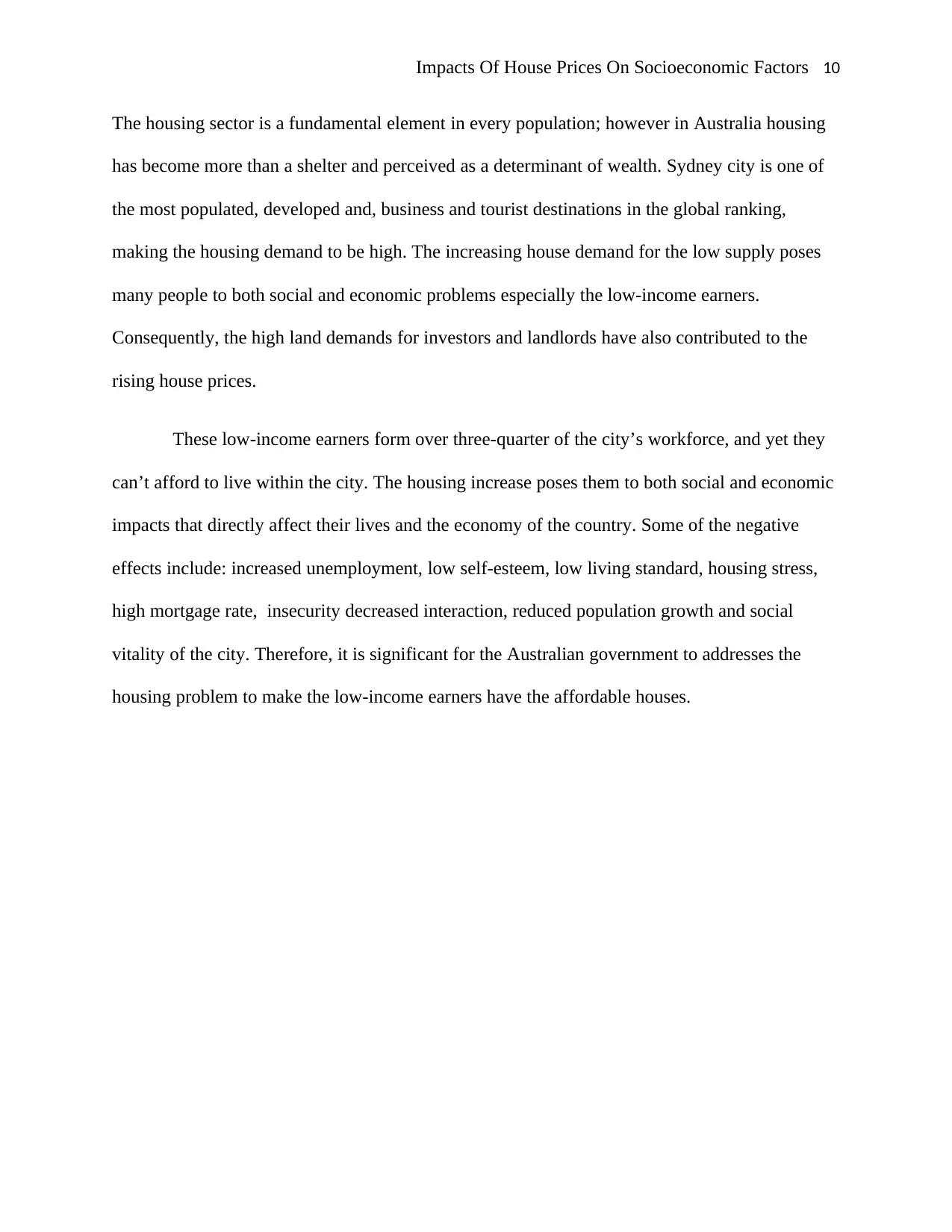
Impacts Of House Prices On Socioeconomic Factors 10
The housing sector is a fundamental element in every population; however in Australia housing
has become more than a shelter and perceived as a determinant of wealth. Sydney city is one of
the most populated, developed and, business and tourist destinations in the global ranking,
making the housing demand to be high. The increasing house demand for the low supply poses
many people to both social and economic problems especially the low-income earners.
Consequently, the high land demands for investors and landlords have also contributed to the
rising house prices.
These low-income earners form over three-quarter of the city’s workforce, and yet they
can’t afford to live within the city. The housing increase poses them to both social and economic
impacts that directly affect their lives and the economy of the country. Some of the negative
effects include: increased unemployment, low self-esteem, low living standard, housing stress,
high mortgage rate, insecurity decreased interaction, reduced population growth and social
vitality of the city. Therefore, it is significant for the Australian government to addresses the
housing problem to make the low-income earners have the affordable houses.
The housing sector is a fundamental element in every population; however in Australia housing
has become more than a shelter and perceived as a determinant of wealth. Sydney city is one of
the most populated, developed and, business and tourist destinations in the global ranking,
making the housing demand to be high. The increasing house demand for the low supply poses
many people to both social and economic problems especially the low-income earners.
Consequently, the high land demands for investors and landlords have also contributed to the
rising house prices.
These low-income earners form over three-quarter of the city’s workforce, and yet they
can’t afford to live within the city. The housing increase poses them to both social and economic
impacts that directly affect their lives and the economy of the country. Some of the negative
effects include: increased unemployment, low self-esteem, low living standard, housing stress,
high mortgage rate, insecurity decreased interaction, reduced population growth and social
vitality of the city. Therefore, it is significant for the Australian government to addresses the
housing problem to make the low-income earners have the affordable houses.
Paraphrase This Document
Need a fresh take? Get an instant paraphrase of this document with our AI Paraphraser
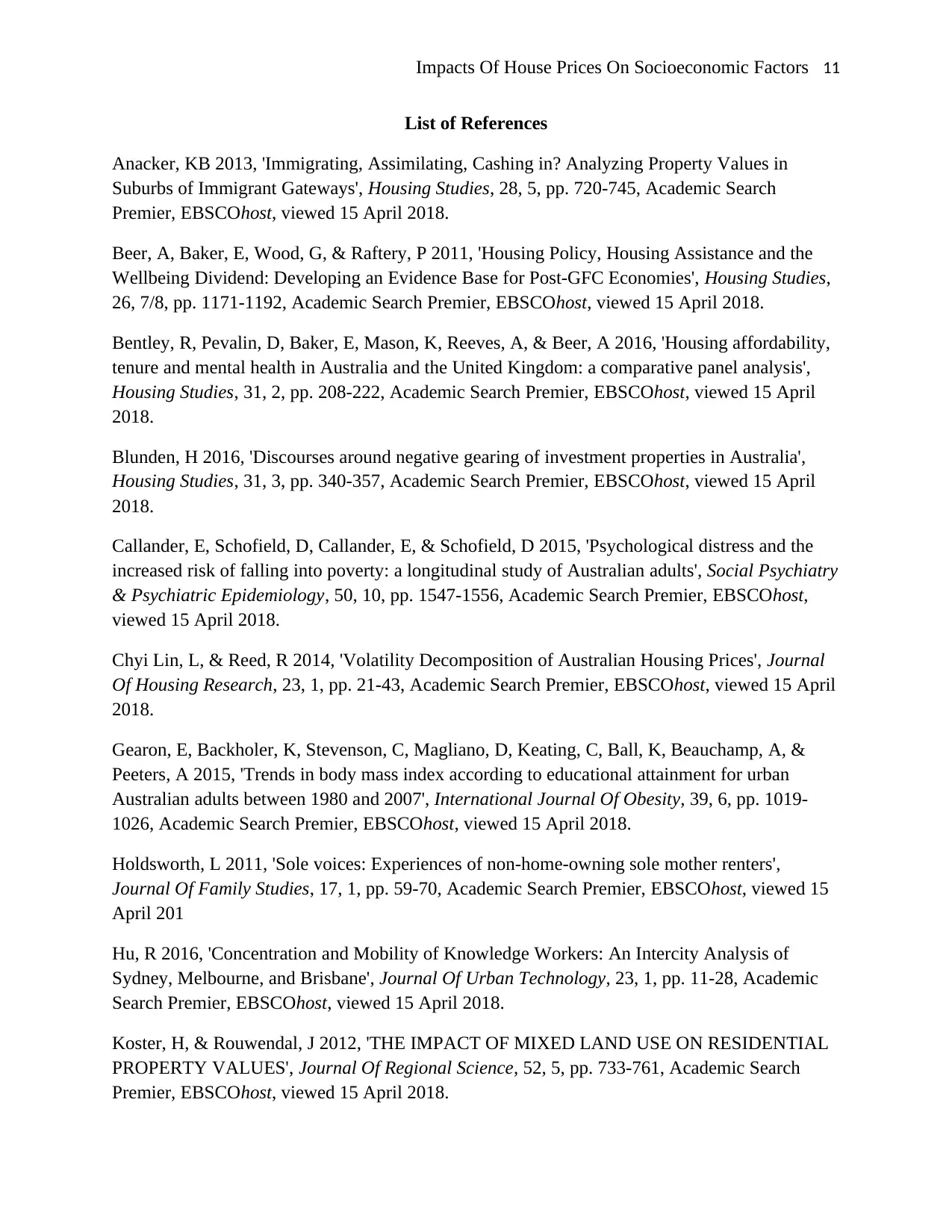
Impacts Of House Prices On Socioeconomic Factors 11
List of References
Anacker, KB 2013, 'Immigrating, Assimilating, Cashing in? Analyzing Property Values in
Suburbs of Immigrant Gateways', Housing Studies, 28, 5, pp. 720-745, Academic Search
Premier, EBSCOhost, viewed 15 April 2018.
Beer, A, Baker, E, Wood, G, & Raftery, P 2011, 'Housing Policy, Housing Assistance and the
Wellbeing Dividend: Developing an Evidence Base for Post-GFC Economies', Housing Studies,
26, 7/8, pp. 1171-1192, Academic Search Premier, EBSCOhost, viewed 15 April 2018.
Bentley, R, Pevalin, D, Baker, E, Mason, K, Reeves, A, & Beer, A 2016, 'Housing affordability,
tenure and mental health in Australia and the United Kingdom: a comparative panel analysis',
Housing Studies, 31, 2, pp. 208-222, Academic Search Premier, EBSCOhost, viewed 15 April
2018.
Blunden, H 2016, 'Discourses around negative gearing of investment properties in Australia',
Housing Studies, 31, 3, pp. 340-357, Academic Search Premier, EBSCOhost, viewed 15 April
2018.
Callander, E, Schofield, D, Callander, E, & Schofield, D 2015, 'Psychological distress and the
increased risk of falling into poverty: a longitudinal study of Australian adults', Social Psychiatry
& Psychiatric Epidemiology, 50, 10, pp. 1547-1556, Academic Search Premier, EBSCOhost,
viewed 15 April 2018.
Chyi Lin, L, & Reed, R 2014, 'Volatility Decomposition of Australian Housing Prices', Journal
Of Housing Research, 23, 1, pp. 21-43, Academic Search Premier, EBSCOhost, viewed 15 April
2018.
Gearon, E, Backholer, K, Stevenson, C, Magliano, D, Keating, C, Ball, K, Beauchamp, A, &
Peeters, A 2015, 'Trends in body mass index according to educational attainment for urban
Australian adults between 1980 and 2007', International Journal Of Obesity, 39, 6, pp. 1019-
1026, Academic Search Premier, EBSCOhost, viewed 15 April 2018.
Holdsworth, L 2011, 'Sole voices: Experiences of non-home-owning sole mother renters',
Journal Of Family Studies, 17, 1, pp. 59-70, Academic Search Premier, EBSCOhost, viewed 15
April 201
Hu, R 2016, 'Concentration and Mobility of Knowledge Workers: An Intercity Analysis of
Sydney, Melbourne, and Brisbane', Journal Of Urban Technology, 23, 1, pp. 11-28, Academic
Search Premier, EBSCOhost, viewed 15 April 2018.
Koster, H, & Rouwendal, J 2012, 'THE IMPACT OF MIXED LAND USE ON RESIDENTIAL
PROPERTY VALUES', Journal Of Regional Science, 52, 5, pp. 733-761, Academic Search
Premier, EBSCOhost, viewed 15 April 2018.
List of References
Anacker, KB 2013, 'Immigrating, Assimilating, Cashing in? Analyzing Property Values in
Suburbs of Immigrant Gateways', Housing Studies, 28, 5, pp. 720-745, Academic Search
Premier, EBSCOhost, viewed 15 April 2018.
Beer, A, Baker, E, Wood, G, & Raftery, P 2011, 'Housing Policy, Housing Assistance and the
Wellbeing Dividend: Developing an Evidence Base for Post-GFC Economies', Housing Studies,
26, 7/8, pp. 1171-1192, Academic Search Premier, EBSCOhost, viewed 15 April 2018.
Bentley, R, Pevalin, D, Baker, E, Mason, K, Reeves, A, & Beer, A 2016, 'Housing affordability,
tenure and mental health in Australia and the United Kingdom: a comparative panel analysis',
Housing Studies, 31, 2, pp. 208-222, Academic Search Premier, EBSCOhost, viewed 15 April
2018.
Blunden, H 2016, 'Discourses around negative gearing of investment properties in Australia',
Housing Studies, 31, 3, pp. 340-357, Academic Search Premier, EBSCOhost, viewed 15 April
2018.
Callander, E, Schofield, D, Callander, E, & Schofield, D 2015, 'Psychological distress and the
increased risk of falling into poverty: a longitudinal study of Australian adults', Social Psychiatry
& Psychiatric Epidemiology, 50, 10, pp. 1547-1556, Academic Search Premier, EBSCOhost,
viewed 15 April 2018.
Chyi Lin, L, & Reed, R 2014, 'Volatility Decomposition of Australian Housing Prices', Journal
Of Housing Research, 23, 1, pp. 21-43, Academic Search Premier, EBSCOhost, viewed 15 April
2018.
Gearon, E, Backholer, K, Stevenson, C, Magliano, D, Keating, C, Ball, K, Beauchamp, A, &
Peeters, A 2015, 'Trends in body mass index according to educational attainment for urban
Australian adults between 1980 and 2007', International Journal Of Obesity, 39, 6, pp. 1019-
1026, Academic Search Premier, EBSCOhost, viewed 15 April 2018.
Holdsworth, L 2011, 'Sole voices: Experiences of non-home-owning sole mother renters',
Journal Of Family Studies, 17, 1, pp. 59-70, Academic Search Premier, EBSCOhost, viewed 15
April 201
Hu, R 2016, 'Concentration and Mobility of Knowledge Workers: An Intercity Analysis of
Sydney, Melbourne, and Brisbane', Journal Of Urban Technology, 23, 1, pp. 11-28, Academic
Search Premier, EBSCOhost, viewed 15 April 2018.
Koster, H, & Rouwendal, J 2012, 'THE IMPACT OF MIXED LAND USE ON RESIDENTIAL
PROPERTY VALUES', Journal Of Regional Science, 52, 5, pp. 733-761, Academic Search
Premier, EBSCOhost, viewed 15 April 2018.
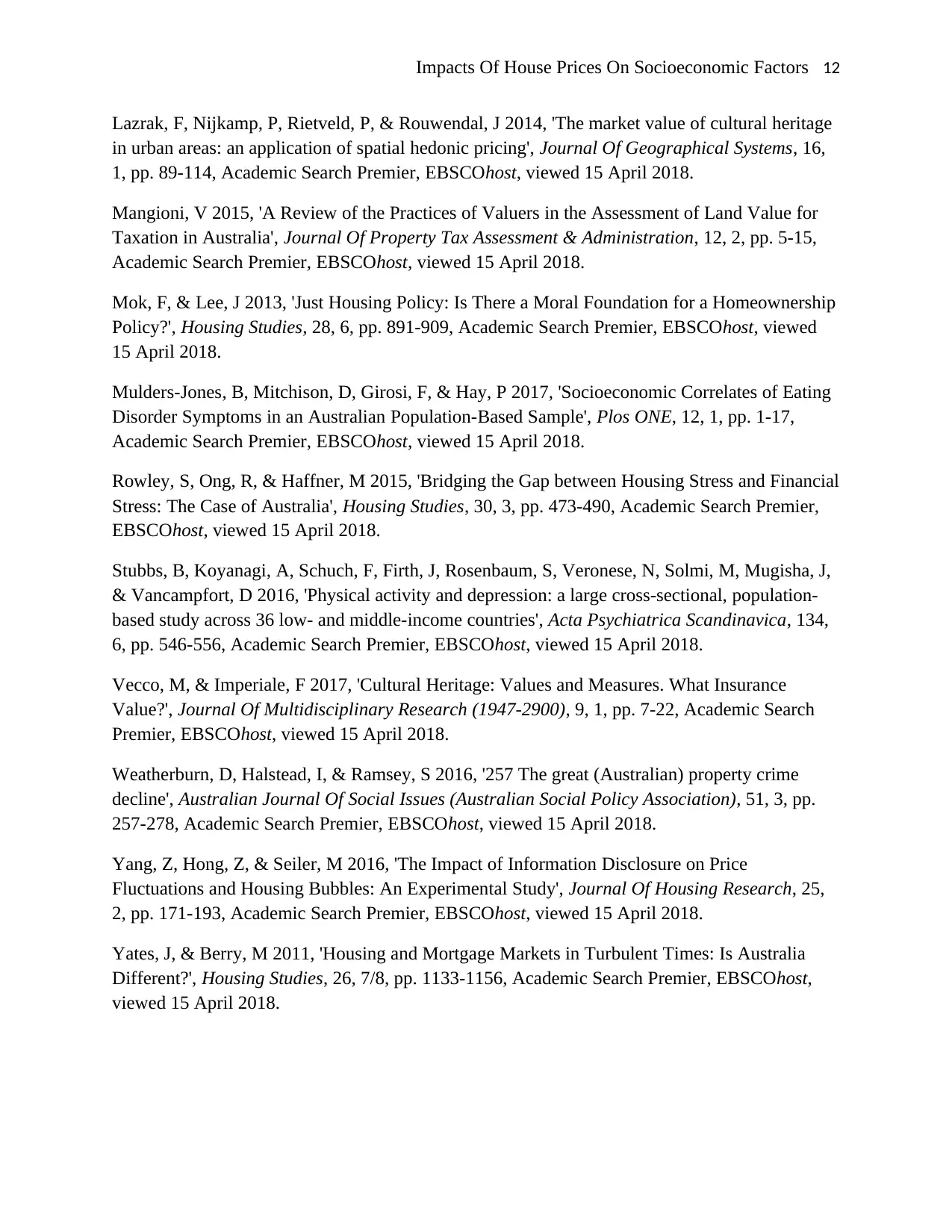
Impacts Of House Prices On Socioeconomic Factors 12
Lazrak, F, Nijkamp, P, Rietveld, P, & Rouwendal, J 2014, 'The market value of cultural heritage
in urban areas: an application of spatial hedonic pricing', Journal Of Geographical Systems, 16,
1, pp. 89-114, Academic Search Premier, EBSCOhost, viewed 15 April 2018.
Mangioni, V 2015, 'A Review of the Practices of Valuers in the Assessment of Land Value for
Taxation in Australia', Journal Of Property Tax Assessment & Administration, 12, 2, pp. 5-15,
Academic Search Premier, EBSCOhost, viewed 15 April 2018.
Mok, F, & Lee, J 2013, 'Just Housing Policy: Is There a Moral Foundation for a Homeownership
Policy?', Housing Studies, 28, 6, pp. 891-909, Academic Search Premier, EBSCOhost, viewed
15 April 2018.
Mulders-Jones, B, Mitchison, D, Girosi, F, & Hay, P 2017, 'Socioeconomic Correlates of Eating
Disorder Symptoms in an Australian Population-Based Sample', Plos ONE, 12, 1, pp. 1-17,
Academic Search Premier, EBSCOhost, viewed 15 April 2018.
Rowley, S, Ong, R, & Haffner, M 2015, 'Bridging the Gap between Housing Stress and Financial
Stress: The Case of Australia', Housing Studies, 30, 3, pp. 473-490, Academic Search Premier,
EBSCOhost, viewed 15 April 2018.
Stubbs, B, Koyanagi, A, Schuch, F, Firth, J, Rosenbaum, S, Veronese, N, Solmi, M, Mugisha, J,
& Vancampfort, D 2016, 'Physical activity and depression: a large cross-sectional, population-
based study across 36 low- and middle-income countries', Acta Psychiatrica Scandinavica, 134,
6, pp. 546-556, Academic Search Premier, EBSCOhost, viewed 15 April 2018.
Vecco, M, & Imperiale, F 2017, 'Cultural Heritage: Values and Measures. What Insurance
Value?', Journal Of Multidisciplinary Research (1947-2900), 9, 1, pp. 7-22, Academic Search
Premier, EBSCOhost, viewed 15 April 2018.
Weatherburn, D, Halstead, I, & Ramsey, S 2016, '257 The great (Australian) property crime
decline', Australian Journal Of Social Issues (Australian Social Policy Association), 51, 3, pp.
257-278, Academic Search Premier, EBSCOhost, viewed 15 April 2018.
Yang, Z, Hong, Z, & Seiler, M 2016, 'The Impact of Information Disclosure on Price
Fluctuations and Housing Bubbles: An Experimental Study', Journal Of Housing Research, 25,
2, pp. 171-193, Academic Search Premier, EBSCOhost, viewed 15 April 2018.
Yates, J, & Berry, M 2011, 'Housing and Mortgage Markets in Turbulent Times: Is Australia
Different?', Housing Studies, 26, 7/8, pp. 1133-1156, Academic Search Premier, EBSCOhost,
viewed 15 April 2018.
Lazrak, F, Nijkamp, P, Rietveld, P, & Rouwendal, J 2014, 'The market value of cultural heritage
in urban areas: an application of spatial hedonic pricing', Journal Of Geographical Systems, 16,
1, pp. 89-114, Academic Search Premier, EBSCOhost, viewed 15 April 2018.
Mangioni, V 2015, 'A Review of the Practices of Valuers in the Assessment of Land Value for
Taxation in Australia', Journal Of Property Tax Assessment & Administration, 12, 2, pp. 5-15,
Academic Search Premier, EBSCOhost, viewed 15 April 2018.
Mok, F, & Lee, J 2013, 'Just Housing Policy: Is There a Moral Foundation for a Homeownership
Policy?', Housing Studies, 28, 6, pp. 891-909, Academic Search Premier, EBSCOhost, viewed
15 April 2018.
Mulders-Jones, B, Mitchison, D, Girosi, F, & Hay, P 2017, 'Socioeconomic Correlates of Eating
Disorder Symptoms in an Australian Population-Based Sample', Plos ONE, 12, 1, pp. 1-17,
Academic Search Premier, EBSCOhost, viewed 15 April 2018.
Rowley, S, Ong, R, & Haffner, M 2015, 'Bridging the Gap between Housing Stress and Financial
Stress: The Case of Australia', Housing Studies, 30, 3, pp. 473-490, Academic Search Premier,
EBSCOhost, viewed 15 April 2018.
Stubbs, B, Koyanagi, A, Schuch, F, Firth, J, Rosenbaum, S, Veronese, N, Solmi, M, Mugisha, J,
& Vancampfort, D 2016, 'Physical activity and depression: a large cross-sectional, population-
based study across 36 low- and middle-income countries', Acta Psychiatrica Scandinavica, 134,
6, pp. 546-556, Academic Search Premier, EBSCOhost, viewed 15 April 2018.
Vecco, M, & Imperiale, F 2017, 'Cultural Heritage: Values and Measures. What Insurance
Value?', Journal Of Multidisciplinary Research (1947-2900), 9, 1, pp. 7-22, Academic Search
Premier, EBSCOhost, viewed 15 April 2018.
Weatherburn, D, Halstead, I, & Ramsey, S 2016, '257 The great (Australian) property crime
decline', Australian Journal Of Social Issues (Australian Social Policy Association), 51, 3, pp.
257-278, Academic Search Premier, EBSCOhost, viewed 15 April 2018.
Yang, Z, Hong, Z, & Seiler, M 2016, 'The Impact of Information Disclosure on Price
Fluctuations and Housing Bubbles: An Experimental Study', Journal Of Housing Research, 25,
2, pp. 171-193, Academic Search Premier, EBSCOhost, viewed 15 April 2018.
Yates, J, & Berry, M 2011, 'Housing and Mortgage Markets in Turbulent Times: Is Australia
Different?', Housing Studies, 26, 7/8, pp. 1133-1156, Academic Search Premier, EBSCOhost,
viewed 15 April 2018.
⊘ This is a preview!⊘
Do you want full access?
Subscribe today to unlock all pages.

Trusted by 1+ million students worldwide
1 out of 12
Related Documents
Your All-in-One AI-Powered Toolkit for Academic Success.
+13062052269
info@desklib.com
Available 24*7 on WhatsApp / Email
![[object Object]](/_next/static/media/star-bottom.7253800d.svg)
Unlock your academic potential
Copyright © 2020–2025 A2Z Services. All Rights Reserved. Developed and managed by ZUCOL.





